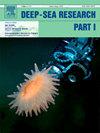An unexpected journey – the arctic deep-sea halicreatid trachymedusa Botrynema brucei ellinorae off Florida: a reassessment under an integrative taxonomic approach
IF 2.1
3区 地球科学
Q2 OCEANOGRAPHY
Deep-Sea Research Part I-Oceanographic Research Papers
Pub Date : 2025-07-03
DOI:10.1016/j.dsr.2025.104551
引用次数: 0
Abstract
The study of the trachymedusa Botrynema has a long history of research, encompassing over 120 years of exploration in the deep sea. Two distinct morphotypes are recognized within Botrynema: one with a characteristic apical knob and another without it. Both morphotypes are present in the subspecies B. brucei ellinorae, while only specimens with a knob are known for the remainder of B. brucei. Specimens with a knob have been reported across all oceans and latitudes, whereas specimens without a knob are only known from Arctic and Subarctic regions. In this study, we use historical records, molecular tools and phylogenetic analyses to challenge the widely accepted notion of a cosmopolitan distribution for B. brucei as traditionally understood. We propose a range expansion to the subtropical western Atlantic Ocean for B. brucei ellinorae based on molecular data and hypothesize the existence of a mesopelagic soft barrier in the North Atlantic region as a plausible explanation to emerging biogeographical patterns revealed in this study.
意想不到的旅程——佛罗里达海域的北极深海盐藻:综合分类方法下的重新评估
对粗口水母(trachymedusa Botrynema)的研究历史悠久,在深海中进行了120多年的探索。Botrynema有两种不同的形态:一种具有特征性的顶端旋钮,另一种没有。这两种形态都存在于布氏杆菌亚种ellinorae中,而其余的布氏杆菌只知道带有旋钮的标本。有旋钮的标本在所有海洋和纬度都有报道,而没有旋钮的标本仅在北极和亚北极地区已知。在这项研究中,我们使用历史记录、分子工具和系统发育分析来挑战被广泛接受的布氏杆菌世界分布的传统观念。基于分子数据,作者提出布氏杆菌的分布范围扩展到亚热带西大西洋,并假设北大西洋地区存在中上层软屏障,这是本研究揭示的新兴生物地理格局的合理解释。
本文章由计算机程序翻译,如有差异,请以英文原文为准。
求助全文
约1分钟内获得全文
求助全文
来源期刊
CiteScore
4.60
自引率
4.20%
发文量
144
审稿时长
18.3 weeks
期刊介绍:
Deep-Sea Research Part I: Oceanographic Research Papers is devoted to the publication of the results of original scientific research, including theoretical work of evident oceanographic applicability; and the solution of instrumental or methodological problems with evidence of successful use. The journal is distinguished by its interdisciplinary nature and its breadth, covering the geological, physical, chemical and biological aspects of the ocean and its boundaries with the sea floor and the atmosphere. In addition to regular "Research Papers" and "Instruments and Methods" papers, briefer communications may be published as "Notes". Supplemental matter, such as extensive data tables or graphs and multimedia content, may be published as electronic appendices.

 求助内容:
求助内容: 应助结果提醒方式:
应助结果提醒方式:


